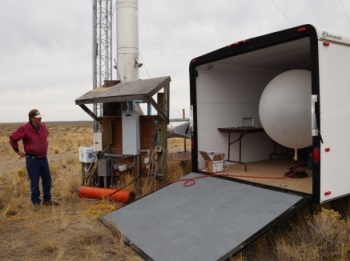October 17, 2013
ARL’s Field Research Division (FRD) has planned a series of atmospheric tracer studies to revisit older studies, conducted in the 1950s and 1960s, on short-range dispersion in open terrain. The new studies, called Project Sagebrush, began September 30, 2013 and will extend over several years. FRD will use its modern meteorological instrumentation and tracer technology, which were not available during the older dispersion studies. Project Sagebrush will take place at FRD’s tracer release facility, located on the Department of Energy’s Idaho National Laboratory (INL). Results will provide a modern set of tracer data, along with high quality measurements collected from an extensive set of sensors in the boundary layer (the mixed layer of the atmosphere closest to and most influenced by the Earth’s surface). The results will be highly useful to the dispersion research community both for understanding short-range dispersion in open terrain and for developing, improving, and testing dispersion models. Partners include the Washington State University and the University of Tennessee Space Institute.
Background: In 1956, a field program called Project Prairie Grass was conducted to provide experimental data on the short-range diffusion of a tracer gas. The tracer gas was sulfur dioxide and releases were made over a flat prairie in Nebraska during the months of July and August. Results from the Prairie Grass experiments, as well as a few other “classical” dispersion studies, conducted in the 1950s and 1960s, have largely been the bases of many, if not most, atmospheric dispersion calculations and models in use even today. This is largely because dispersion studies are expensive to carry out. Yet, over the decades there have been many technological advances in tracers and instruments. Recent dispersion experiments conducted by FRD have found different results than Project Prairie Grass in stable atmospheric conditions.
Significance: Atmospheric dispersion models are primary tools used by emergency managers and first responders to determine appropriate responses to chemical, biological, and nuclear incidents. They are also useful tools for air quality managers in understanding the transport of air pollution. Over the years, dispersion models and measurement technologies have advanced. Thus, it is vitally important that models be validated with modern data to determine their accuracy. Since actual toxic material cannot be released into the atmosphere during an experiment, tracers (benign material), that mimic a real threat, are used instead. FRD’s tracer studies yield a host of critical information that can then be used to validate and improve models that determine chronic and acute exposure risks to humans, should an event occur.

ARL’s Field Research Division Director prepares a weather balloon that will be released into the air for the Project Sagebrush study. The balloon is one of several instruments FRD and partners are using to collect data for this study.
Image Source: NOAA/ARL

